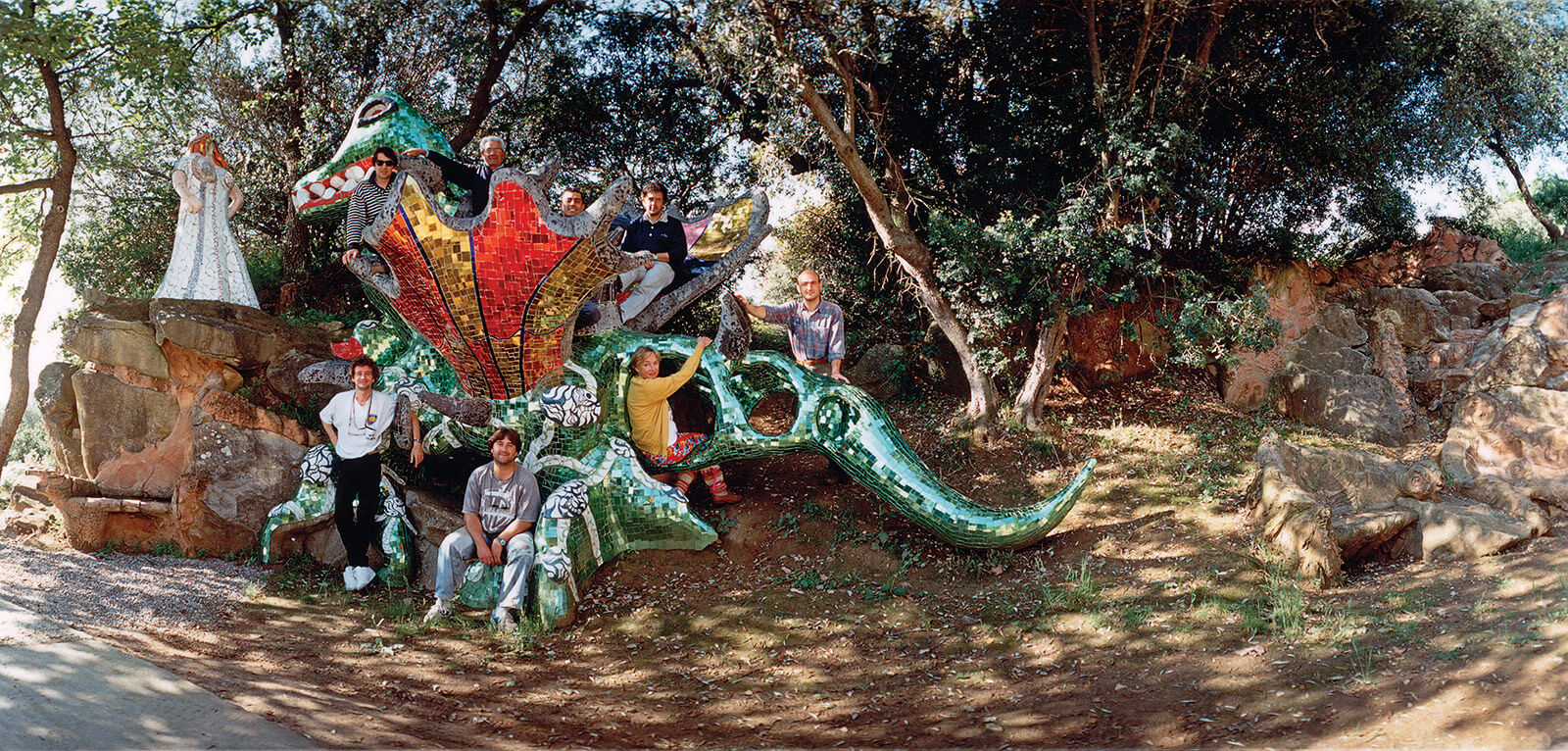The enlargement of my models was made perfectly with a medieval eye, by Jean Tinguely and Doc Winsen. All of the monumental sculptures armatures were made from welded steel bars, formed by brute strength on the knees of the crew. The first crew who welded in the garden were: Jean Tinguely, Rico Weber and Seppi Imhof. They built the Sphinx, The High Priestress and the Magician.
The Pope was started by Doc Winsen and finished by Jean Tinguely, it was Jean's favorite sculpture of all the garden. The second half of the Tarot Garden; The Emperor's Castle, The Sun, The Dragon (Strength), and The Tree of Life (The Hanged Man) were welded by Doc Winsen, a Dutch artist. Doc was assisted by Tonino Urtis.
Next came Ugo, the postman, who began by making stone paths, and then graduated to putting the wire mesh on the steel structures to receive the cement. Later Ugo would ask me to try his hand at putting the mirrors on the sculptures. He has become a poet of putting on mirrors. He's always always afraid there would be no more work for him. I have made the solemn promise that I would make sure that there was always something new to do each year, and if I run out of ideas, I will make a wall of China around the garden that should take several generations to finish.
Once the steel armatures were finished and the wire mesh was stretched over them, they were ready for gunite cement which was sprayed on. The sculptures then had a melancholy look with a certain sad beauty. My purpose, however, was to make a garden of joy. The finishing of the cement was later done by hand with Marco Iacotonio, a very beautiful and difficult young man.
Early on I chose Tonino Urtis to be the head of the crew, even though he had no experience; he had been an electrician before. I have always used my instinct in my choices, not my brain, and very often these choices proved right. I then asked Ricardo Menon, my personal assistant, collaborator and great friend who had come with me from Paris, to find me a ceramist. A few days later Ricardo presented me with Venera Finocchiaro. Venera would become the ceramist of the garden. It was total immersion. She lived at the garden and responded to my asking her to do new things in ceramics that had not been done before. The magnificent work she produced speaks for itself. She has several assistants, the main ones being Paola, Patrizia and Gemma.
Sometimes the whole team helped at the ovens. When Venera left, the ceramics were continued by the team.
The twentieth century was forgotten. We were working Egyptian style. The ceramics were molded, in most cases, right on the sculptures, numbered, taken off, carried to the ovens, cooked and glazed, and then put back in place on the sculptures. When ceramics are cooked there is a 10% loss in size, so the resulting empty space around the ceramics were filled in with hand cut pieces of glass. This was done by a variety of different people-the main ones being Marco Iacotonio, Tonino Urtis and Claudio Celleti.
The smaller sculptures in the garden were made in Paris. My assistant Marcello Zitelli and I made the clay models which were reproduced in polyester by Robert Haligon and his sons Gerard and Oliver. The polyester sculptures were then covered with a mosaic of tiles made with glass from Murano, Czechoslovakia and France, by Pierre Marie Lejeune and his wife Isabelle.
In this way Temperance, Adam and Eve (The Choice), The World, The Hermit, The Oracle, Death, The Devil and the Hanged Man were created.
Pierre Marie Lejeune, who painted the Stravinsky Fountain with me, came to the Tarot Garden and fell in love with it. He returned there one year after another. His specialty became cutting mirrors with a focus on innovative work.
The administrative work and attending to the various problems of the garden were managed by Gigi Pecoraro and Paula Aureli. But the tutelary deity of the garden was Jean Gabriel Mitterrand, who came whenever there was a problem that he could help us solve. In recent years Tonino Urtis, Ugo Celletti, Marco Iacotonio and Claudio Celletti remained.
We all share an immense enthusiasm for the garden and have become like a family. Recently Gian Piero Ottavi joined us to take care of the garden soil. I decided to respect the natural habitat of the region. The dialogue between nature and sculptures is a very important part of the garden.
The artists who participated with their specific work in the garden are Alan Davie, who painted the magical space within The Wizard. Pierre Marie Lejeune made some ceramic benches integrated into the garden, they are very popular artefacts where people love to sit and admire the fountains. Some chairs in the Sphinx were also made by him, and he decorated the boutique. Marina Barella made the sculpture found inside the Priestess. Jean Tinguely made a machine representing the lightning striking the Tower of Babel, The Wheel of Fortune in front of the fountain, a sculpture called Injustice imprisoned inside Justice, and The World in collaboration with me. Jackie Matisse made alchemical glass containers for sacred waters.
Image above from left to right: (Top) Pierre Maire Lejeune, Ugo Celletti, Marco Iacotonio, Tonino Urtis (Bottom) Claudio Celletti, Niki de Saint Phalle, and Gian Piero Ottavi with La Force. Photo: © Giulio Pietromarchi

